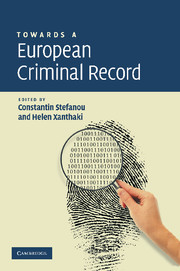Book contents
- Frontmatter
- Contents
- List of contributors
- Preface and acknowledgements
- 1 Introduction: How did the idea of a European Criminal Record come about?
- PART I
- 2 The European Criminal Record: Analysis
- 3 The European Criminal Record: Political parameters
- 4 The establishment of a European Criminal Record: Human rights considerations
- PART II
- PART III
- 19 Conclusions
- Index
3 - The European Criminal Record: Political parameters
Published online by Cambridge University Press: 13 July 2009
- Frontmatter
- Contents
- List of contributors
- Preface and acknowledgements
- 1 Introduction: How did the idea of a European Criminal Record come about?
- PART I
- 2 The European Criminal Record: Analysis
- 3 The European Criminal Record: Political parameters
- 4 The establishment of a European Criminal Record: Human rights considerations
- PART II
- PART III
- 19 Conclusions
- Index
Summary
Introduction
The idea behind the creation of a European Criminal Record was first put forward to the Commission in the political reviser's Report of a Falcone Study on the use of national criminal records, completed in 2000. It was noted in that Report that the existing problems in judicial and enforcement agencies' cooperation across the EU made the use of national criminal records as a means of combating organised crime rather problematic. It was pointed out that practical problems hindered the speed, access and effectiveness of existing methods of cooperation and the creation and use of an ECR was the way forward for the effective combating of organised crime.
Of course, the idea of using databases as a means of combating crime is not new. Practically all enforcement agencies around the world use ‘files’ (in paper or digital form) on crimes, suspects and methods (modus operandi) in an attempt to prevent crime or prosecute criminals. In fact, in recent years digital databases such as the Schengen Information System (SIS) have become the first line of defence against transnational organised crime and plans to update and develop further the system into a SIS II are on the way. What makes the proposal for an ECR different is the idea of an EU-wide dedicated database which addresses the problem directly: in other words, a dedicated database which contains information extracted from national criminal records on selected crimes.
- Type
- Chapter
- Information
- Towards a European Criminal Record , pp. 59 - 78Publisher: Cambridge University PressPrint publication year: 2008



